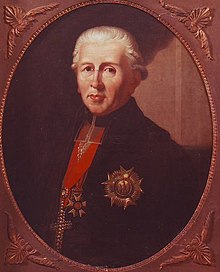Principality of Aschaffenburg
The Principality of Aschaffenburg was built in 1803 with the Reichsdeputationshauptschluss from the remaining right-bank areas of the Mainz Electorate and became a sovereign state within the Confederation of the Rhine , which from 1806 bis 1813 / 14 existed and under the rule of Karl Theodor von Dalberg stood. It became part of the Grand Duchy of Frankfurt in 1810 .
history
Before 1803, the area around Aschaffenburg was a territory of the Upper Archbishopric. In 1803, the archbishopric was dissolved with the Reichsdeputationshauptschluss and the Principality of Aschaffenburg was formed from the Viztumamt Aschaffenburg and the Oberämter Klingenberg , Orb and Lohr as an electorate with an area of around 1,700 km², which was under the rule of the Imperial Arch Chancellor Karl Theodor von Dalberg. Dalberg, who also became Archbishop of Regensburg , ruled the Principality of Aschaffenburg as well as the Principality of Regensburg and the former imperial city of Regensburg as well as the county of Wetzlar (former imperial city and seat of the imperial chamber court ). The imperial city of Frankfurt was incorporated into the territory in 1806 with the establishment of the Rhine Confederation, of which Dalberg was the prince . Dalberg had a arts and crafts school (1807), a university (1808) and in 1811 also a theater built in the former German House (Kommende Aschaffenburg) in Aschaffenburg .
In 1810 Napoleon handed Regensburg over to Bavaria, in return Dalberg got the principalities of Hanau and Fulda . At the same time, the entire territory of Dalberg was united to form the Grand Duchy of Frankfurt, which was divided into the four departments of Aschaffenburg , Frankfurt , Fulda and Hanau . The area of the Grand Duchy was 5,160 km², the population was around 300,000. The residence remained in Aschaffenburg. A constitution based on the French model was enacted on August 16, 1810 , and the Civil Code was introduced in 1811 . Dalberg was a progressive ruler who, among other things, abolished serfdom and compulsory labor, reformed the school and educational system and issued a decree on the emancipation of Jews during his short reign . His political power, however, was limited by the French supremacy. Dalberg left the Grand Duchy on September 30, 1813 and abdicated on October 28 in favor of Napoleon's stepson Eugène de Beauharnais . After the Battle of the Nations near Leipzig , the Grand Duchy fell apart. The area of the former department of Aschaffenburg finally became part of the Kingdom of Bavaria in 1814 . Wetzlar fell to Prussia, while the Free City of Frankfurt regained its sovereignty at the Congress of Vienna .
literature
- Karl von Beaulieu-Marconnay : Karl von Dalberg and his time. On the biography and characteristics of the Prince Primate. 2 volumes. Böhlau, Weimar 1879.
- Konrad M. Färber, Albrecht Klose, Hermann Reidel (eds.): Carl von Dalberg. Archbishop and statesman (1744–1817). Mittelbayerische Druck- und Verlagsgesellschaft, Regensburg 1994, ISBN 3-927529-03-6 (exhibition catalog).
- Hermann Ketterer : The Principality of Aschaffenburg and its transition to the Crown of Bavaria. Festschrift for the memory of the century. On behalf of the Aschaffenburg City Council. Aschaffenburg Magistrate, Aschaffenburg 1915.
- Commission for Bavarian State History at the Bavarian Academy of Sciences (Hrsg.): Historischer Atlas von Bayern. Part: Franconia. Row 1, Issue 12: Günter Christ: Aschaffenburg. Main features of the administration of the Mainz Oberstift and the Dalberg State. Commission for Bavarian State History and others, Munich and others in 1963.

